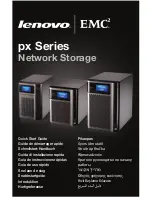
3-4
3
3.2.2
2307 and 2367 Differences
The 2307 and 2367 have an RS-232 and RS-422/RS-485 interface for
communicating serially with the host computer instead of the 4807's GPIB
interface. The 2307/2367 only transfers data with commands and does not
have a transparent data transfer mode. The 2307/2367 uses the same SCPI
commands as the 4807 for controlling its analog and digital functions but
has additional commands for configuring its serial interface. Changes to the
2307/2367's UART take place at power turn-on, when the unit is reset, by
the UPDATE command or by the *RCL 0 command.
The 2307/2367 provides a Service Request Message (SRM ) as a substitute
for the 4807's SRQ signal. The SRM message contains the value of the
Status Byte so the user does not have to query the 2307/2367's Status Byte
Register.
For operation under program control, set Echo off and the 2307/2367 will
send a prompt after each command. The user should wait for the prompt or
a query response before sending the 2307/2367 a new command to avoid
getting out of sync with the 2307/2367. For operation with a terminal or a
computer running a terminal emulation program, set Echo on so that the
2307/2367 will echo back the last command and provide the user with a
visual prompt for the next command.
The RS-232 interface only operates in the Network Off setting and ignores
the Address and Packet settings.
The 2307/2367's RS-422/RS-485 interface is a four-wire interface that
operates in a full or half-duplex modes and may be used with the Network
settings of Off, Address or Packet. The transmitter defaults to being
tristated for multidrop or network connections. Tristated networks should
be used with a terminating network to maintain mark levels when not
transmitting. In the address mode, the 2307/2367 recognizes commands
prefixed with a two-character address sequence. In the packet mode, the
2307/2367 recognizes commands in a packet that contains the 2307/2367's
address and a valid checksum. All packets are responded to with an
acknowledgment (ACK) or an error (NAK) packet. Query responses are
returned in the ACK packet.














































